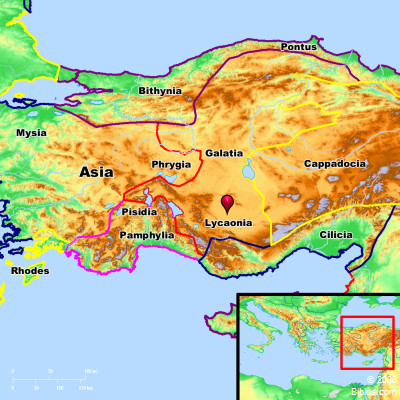Atlas  Lycaonia and surrounding region Maps Created using Biblemapper 3.0 Additional data from OpenBible.info Occurrences Acts 14:6 they became aware of it, and fled to the cities of Lycaonia, Lystra, Derbe, and the surrounding region.Encyclopedia LYCAONIAlik-a-o'-ni-a, li-ka-o'-ni-a (Lukaonia (Acts 14:6), Lukaonisti, (Acts 14:11, "in the speech of Lycaonia"); Lycaonia is meant, according to the South Galatian view, by the expression ten Galatiken choran, in Acts 18:23, and the incidents in Acts 16:1-4 belong to Lycaonia): Was a country in the central and southern part of Asia Minor whose boundaries and extent varied at different periods. In the time of Paul, it was bounded on the North by Galatia proper (but lay in the Roman province Galatia), on the East by Cappadocia, on the South by Cilicia Tracheia, and on the West by Pisidia and Phrygia. The boundary of Phrygia and Lycaonia passed between Iconium and Lystra (see ICONIUM). Lycaonia consists of a level plain, waterless and treeless, rising at its southern fringe for some distance into the foothills of Taurus, and broken on its eastern side by the volcanic mass of Kara-Dagh and by many smaller hills. Strabo informs us that King Amyntas of Galatia fed many flocks of sheep on the Lycaonian plain. Much of the northern portion of Lycaonia has been proved by recent discovery to have belonged to the Roman emperors, who inherited the crown lands of Amyntas. LYCAO'NIA, a province of Asia Minor, bounded n. by Galatia, e. by Cappadocia, s. by Cilicia, and w. by Pisidia and Phrygia. Chief towns, Iconium, Derbe, Lystra. Map No. 7. Strong's Greek G3071: LukaoniaLycaonia, a region in Asia Minor |



